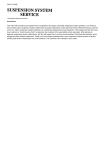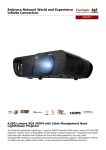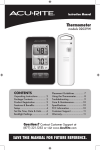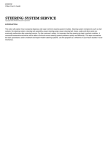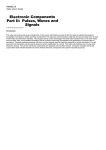Download Video User's Guide
Transcript
Video User's Guide Meridian Education Corporation Introduction This video will demonstrate and explain how to correctly remove, service and replace conventional automotive wheel bearings. It will show you how to service a non-driving tapered wheel bearing and a solid rear axle bearing. You will also learn to remove and install the races, seals and other parts that are associated with these particular types of bearings. The numerous repair variations discussed in this program will better prepare you to service both foreign and domestic wheel bearings. Finally, as a student of auto technology, you must fully understand the importance of following proper bearing removal and installation procedures. Faulty work can cause bearing failure that could lead to serious injuries to others. Student Objectives After viewing this video, you will be able to: • Remove and replace non-driving tapered wheel bearings. • Remove and replace the seal from a non-driving hub assembly. • Inspect a spindle for damage or wear. • Remove and install a tapered wheel bearing's races. • Inspect a tapered wheel bearing's races for problems. • List two ways to "pack" a tapered wheel bearing with grease. • List two ways to adjust a non-driving tapered wheel bearing. • Explain how to use a "slide hammer puller" to remove a solid rear axle. • Describe how to remove and install a retainer plate type axle and a C-clip type axle. • Explain how to remove and replace the bearings, seals and races for retainer plate type axles and C-clip type axles. To The Instructor This video is designed to be a valuable supplement to your curriculum. Since young people are extremely acclimated to television, it is a natural way to help present important aspects of your subject matter. This video is designed to give a detailed, yet broad coverage of the topic. Most educators agree that it is best to use as many instructional methods as possible. Utilise quality textbooks, workbooks, videos, lectures, demonstrations, overheads, and other methods to present the technical information. This will hold interest and help pupils understand the large amount of information required to succeed in today's complex world. This video is organised into major sections or topics. Each section covers one major segment of the subject. Graphic breaks are given between each section so that you can stop the video for class discussion, to answer critical questions, to ask questions or perform inclass demonstrations with actual components or parts. The program's format is arranged to be extremely flexible. View it full length, use it as a supplement for lectures or demonstrations. It can also be used for self-paced individualised instruction. This video allows you to only watch a portion of the program each day or to present the complete video, depending on your curriculum requirements. The program is designed to simplify the complex. Concise wording and carefully selected graphics are used to provide maximum learning in minimum time. Close-up shots of components and service procedures are used to make every second of viewing instructional, as if each student was standing right behind you, watching over your shoulder while you were working or giving a demonstration. Our technical visual Images are designed to match the audio so that every scene has maximum educational value. Computer animation is used to explain difficult to comprehend principles or techniques. Students seem to enjoy the cartoon type Images that show how parts work, how they fit together, or how they vary in design. Quiz Answer Key 1. d 2. a 3. b 4. b 5. c 6. d 7. b 8. c 9. a 10. b II. d 12. c 13. a 14. d 15. b Use your own judgement to evaluate the definitions, definition type questions, and discussion topics. Technical Terms Write definitions for the following terms. Use a textbook or review the video if needed. non-driving tapered wheel bearing, solid rear axle bearing, wheel hub dust cap, cotter pin, spindle adjusting nut, brake drum, rotor, spindle, hub assembly grease seal, inner wheel bearing, outer wheel bearing, disc brakes, inner bearing race, outer bearing race, driver, high temperature grease, bearing packer, torque wrench, dial indicator, axle flange, retainer plate type axle, C-clip type axle, slide hammer puller, axle housing, axle seal, differential, pinion gear, spider gears, differential carrier, bearing collar, hydraulic press, silicone sealer, differential fluid Video Discussion Topics Here are a few topics that might be used for a class discussion. 1. What problems should you look for when inspecting the condition of a spindle? 2. Describe how to remove and install a non-driving hub assembly's bearing races. 3. Describe two methods of "packing" a tapered wheel bearing. 4. What can happen if wheel bearings are not properly lubricated? 5. Explain how to install a non-driving hub assembly back onto its spindle. 6. How is a torque wrench used to adjust non-driving tapered wheel bearings? 7. Describe how to use a "slide hammer" to remove a retainer plate type rear axle. 8. What are the differences between a retainer plate type rear axle and a C-clip type rear axle? Video Quiz Print the appropriate letter in the blank to indicate the most correct answer after reading the statement: 1. To remove a tapered wheel bearing, first pop off the small dust cap on the __________ hub. a. roller b. steering c. retainer d. wheel 2. Any signs of wear on a bearing face would require ___________ and _________ replacement. a. bearing, race b. rotor, spindle c. spindle, race d. drum, spindle 3. When replacing hub and bearing assembly parts, you should always replace the __________ and the ________ as a set. a. spindle, bearing b. race, bearing c. seal, drum d. none of the above 4. When "packing" a tapered wheel bearing, make sure the _________ and all the _________ are fully surrounded with grease. a. retainer, collars b. cage, rollers c. roller, retainers d. seal, retainers 5. __________ are usually provided in the hub so that a mild steel bar can be used to drive out the old bearing race. a. Holes b. Threads c. Notches d. Bolts 6. Grease in the hub assembly serves as an extra supply of grease for the ______________. a. safety washers b. spindle nuts c. steering knuckles d. wheel bearings 7. To service a solid rear axle bearing, you will normally have to remove the ___________ from the end of the axle flange. a. spindle nut b. brake drum c. adjusting nut d. cotter pin 8. On a retainer plate type rear axle, large ____________ are provided in the axle flange so that you can remove the axle retainer plate nuts. a. clips b. grooves c. holes d. sleeves Video Quiz (Continued) 9. When servicing a rear axle and its bearing, always replace the axle ______________. a. seal b. flange c. housing d. clamps 10. When removing a rear axle, always inspect it for signs of wear around the ___________ and ___________ contact surfaces. a. spindle, flange b. seal, bearing c. seal, sleeve d. sleeve, bearing 11. What should be done if a rear axle bearing spins in its housing? a. Replace the axle b. Install oversize bearing c. Reduce the amount of grease in the housing d. Replace the housing 12. The slightest imperfection or damage on any of the bearing’s rollers would require __________ replacement. a. cage b. roller c. bearing d. axle 13. An application of grease will prevent an axle ________ from rubbing on a dry surface when the vehicle is first driven. a. seal b. flange c. plate d. sleeve 14. A __________ slightly ___________ than the axle bearing should be used to drive the bearing fully into place in the axle housing. a. punch, larger b. chisel, smaller c. driver, larger d. driver, smaller 15. Which of the following axle designs requires you to partially disassemble the differential in order to remove the axle from the vehicle? a. Retainer plate type axle b. C-clip type axle c. Collar type axle d. All of the above Short Answer Briefly answer the following questions in your own words. 1. Why should you throw the old cotter pin away when disassembling a wheel bearing and hub assembly? 2. What should you look for when inspecting the condition of a wheel hub's race bore? 3. Describe how to install a non-driving tapered wheel bearing's grease seal. 4. Describe how to use a dial indicator to check a non-driving tapered wheel bearing. 5. Explain how to use a slide hammer to remove an in-housing bearing race. 6. Why is it important to wash off all the old grease when inspecting the condition of a wheel bearing? 7. Why shouldn't you allow a bearing to spin when blowing it dry with compressed air? 8. Explain how to install a retainer plate type axle's wheel bearing. 9. What safety procedures should you follow when driving a new bearing down onto an axle? 10. Describe how to install a C-clip type axle. We Need Your Help! We are constantly trying to improve our videos. If you have any suggestions or comments, please send them to us with details (title, time code location, etc.) of any potential improvement. We will try to incorporate suggestions when revising our videos. Your help will be greatly appreciated. We want to help you train America's youth! Other titles available from Meridian Education Corporation • • • • • • • • • Suspension Systems (Item No.5174) Suspension System Service (Item No.5175) Steering Systems (Item No.5176) Steering System Service (Item No.5189) Brake Systems (Item No.5177) Brake System Service (Item No.5182) Wheel Bearing Service: Front Wheel Drive (Item No.5132) Wheel Alignment Theory & Adjustment (Item No.5164) CV-Axle Service (Item No. 5178)







